Related Research Articles

The Tamworth, also known as Sandy Back and Tam, is a breed of domestic pig originating in its namesake Tamworth, Staffordshire United Kingdom. It is among the oldest of pig breeds, but as with many older breeds of livestock, it is not well suited to modern production methods and is listed as "threatened" in the United States and "vulnerable" in the UK by the Rare Breeds Survival Trust, as fewer than 300 registered breeding females remain. This animal is of ginger to red colouration and is thought to have descended from wild boars, via native pig stock of Europe. Principal populations today are in the United Kingdom, Australia, the United States, New Zealand, and Canada.
The American Landrace is a medium to large breed of domestic pig, white in color, with long bodies, fine hair, long snouts, and heavy, drooping ears. They are bred for pork production
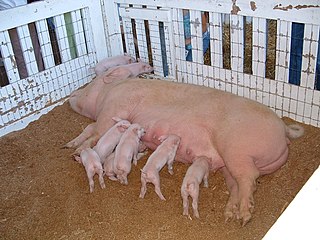
The American Yorkshire is an American breed of large domestic pig. It is the most numerous pig breed in the United States. It derives from pigs of the British Large White or Yorkshire breed imported from the United Kingdom or from Canada at various times from about 1830 to the mid-twentieth century.
Mulefoot are a breed of domestic pig which is named for its intact, uncloven hooves reminiscent of a mule.

The Essex is a breed of domestic pig originating in the United Kingdom.

The Berkshire is a British breed of pig. It originated in the English county of Berkshire, for which it is named. It is normally black, with some white on the snout, on the lower legs, and on the tip of the tail.
The Aksai Black Pied is a distinctively black and white spotted pig breed from Kazakhstan.

The Poland China is an American breed of domestic pig. It was first bred in Warren County in Ohio, in the American Midwest. Its origins lie in a small number of pigs of Chinese type bought in 1816, which were cross-bred with a variety of breeds of European origin including the Berkshire. It was bred as a lard pig, and is among the largest of all pig breeds.
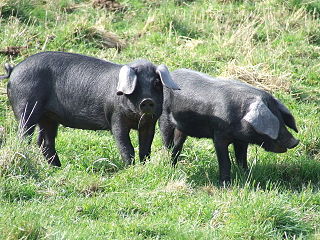
The Large Black pig is a British breed of domestic pig. It is the only British pig that is entirely black. It was created in the last years of the nineteenth century by merging the black pig populations of Devon and Cornwall in the south-west with those of Essex, Suffolk and Kent in the south-east. It is hardy, docile and prolific; it forages well and is suitable for extensive farming, but not well suited to intensive management.
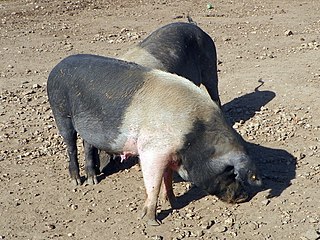
The British Saddleback is a modern British breed of domestic pig. It was created in 1967 by merging the surviving populations of two traditional saddleback breeds, the Essex and Wessex Saddleback.
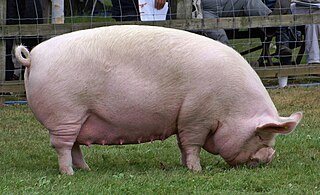
The Middle White is a British breed of domestic pig. It originated in Yorkshire, and derived from the Large White and the now-extinct Small White. It was recognised in 1852, and the first herd-book was published in 1884. It is a porker, reared for fresh pork, and is characterised by a short and sharply-upturned snout. After the Second World War it came close to extinction; although numbers have recovered somewhat, it is listed by the Rare Breeds Survival Trust as "priority" – the highest level of risk.

The Welsh is a breed of domestic pig native to Wales. It is a large white breed known for its hardiness in outdoor (extensive) farming, its long, pear-shaped body and its lop-ears. The breed was first mentioned in the 1870s, and after the Howitt committee report in 1955, became the third most common sire in the United Kingdom after the Large White pig and British Landrace pig. The Welsh pig experienced a decline in numbers in the late twentieth century because consumer demands had changed and the carcase was considered too fatty. In 2005 the breed was considered endangered and later came under the auspices of the Rare Breeds Survival Trust. Since then numbers have expanded somewhat, and by 2012, the registered breeding herd had increased to over 1000 animals.
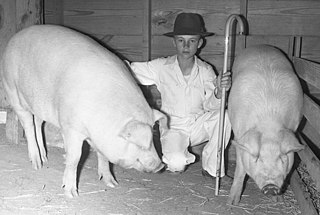
The Chester White is a breed of domestic pig which originated in Chester County, Pennsylvania. It was formerly known as the Chester County White.
The Cumberland was a breed of domestic pig that originated in the North of England; it was used to produce local delicacies like the Cumberland sausage and Cumberland ham. The breed became extinct in 1960, after changes in farming methods and a demand for less fatty meat led to it falling out of favour.
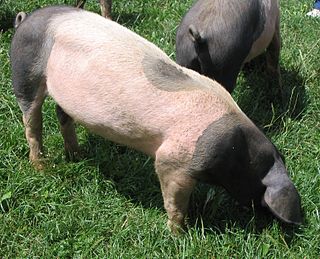
The Swabian-Hall swine is a breed of domestic pig originating from Schwäbisch Hall in Baden-Württemberg, Germany. It is a large pig, white in the centre with a black head and rear and narrow grey bands at the transition from white to black skin. They have large litters averaging more than nine piglets.

The British Landrace is a British domestic breed of pig and one of the most popular in the United Kingdom. It is white with heavy drooping ears that cover most of the face and is bred for pork and bacon. The breed originated in the 1949 importation of 12 landrace pigs from Scandinavia — four boars and eight gilts. In 1950, the British Landrace Pig Society was formed and it opened a herd book for the first offspring born from the imported 12. They created the first pig testing scheme with a testing station at the village of Stockton-on-the-Forest in North Yorkshire.
The Hereford, often called the Hereford Hog, is a breed of domestic pig named for its color and pattern, which is similar to that of the Hereford breed of cattle: red with a white face.
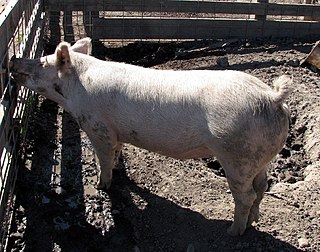
The Australian Yorkshire is a breed of domestic pig from Australia that was originally a part of the Yorkshire breed of pigs from Yorkshire, England. It is said to be the most common and popular breed of pig in Australia due to economic and nutritional advantages.
The Dutch Landrace pig is a standardized breed of domestic pig originating in the Netherlands. The breed was developed from the native landrace of pigs of the area, crossbred with strains from neighboring counties. The Dutch Landrace is considered "a meaty and efficient breed". The breed is unusually responsive to the halothane test, which can be used to weed out individuals with low projected survivability and meat production.
The Large White Ulster, or Ulster White, was a breed of domestic pig. Primarily bred for bacon production, it was the favoured breed of farmers in the north of Ireland up until the mid 20th century.
References
- 1 2 3 Ekarius, Carol (2008). Storey's Illustrated Breed Guide to Sheep, Goats, Cattle and Pigs. p. 196. ISBN 978-1-60342-036-5.
- ↑ "Lacombe swine is poster pig for endangered farm animals". Edmonton Journal . September 23, 2007. Archived from the original on June 28, 2011.
- ↑ "Lacombe". ansi.okstate.edu. Oklahoma State University Dept. of Animal Science. Archived from the original on 2011-07-20.
- ↑ "Pig Breeds". rarebreedscanada.ca. Archived from the original on 2012-03-20.